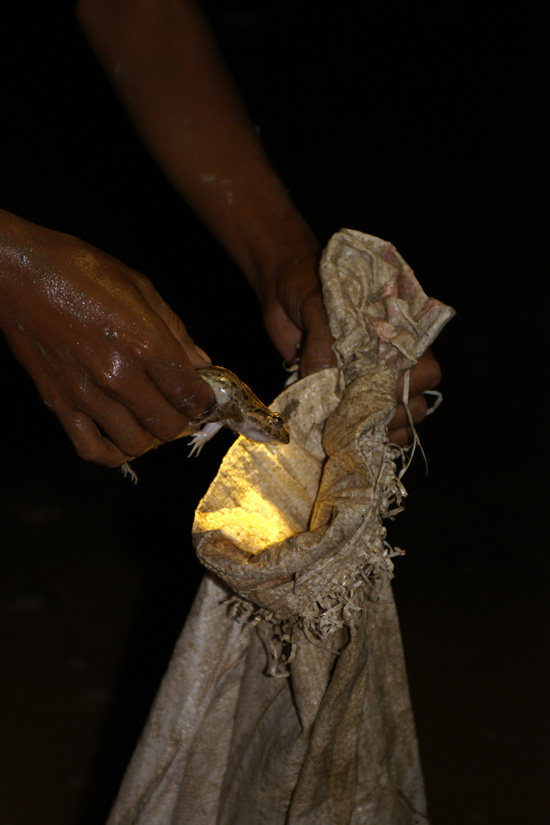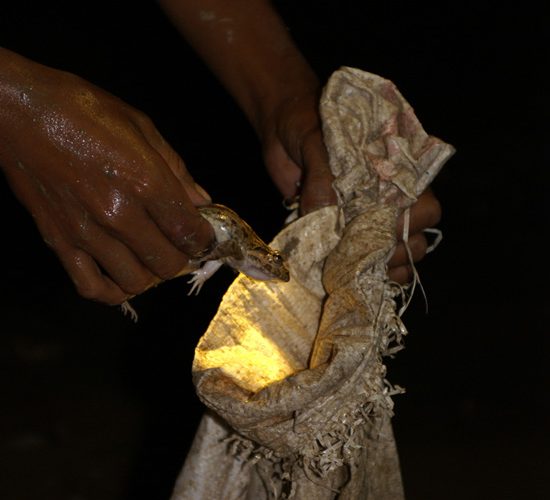
Picture: Catching frog in Cà Mau.
Photo: Quang Hung
Vietnam Heritage, November-December 2011 — When I got home to Cà Mau, Vietnam’s wide peninsula in the far south, black catfish were in the yard. In a short time my son caught a kilogram of them, their bellies full of eggs. These jumping fish are called ‘rising’. There had been no pond to shelter them in the dry. Where had they come from?
At twilight, frogs and tree frogs emerged and croaked all over and around fields. People from my hamlet, C? V?nh, prepared baskets, lamps and knives. We mingled in the crowd. For the seven dry months, June to December, the fields had been desolate. After only an overnight fall of rain they were revived. Our team of father and son went where bushes of trâm b?u (Combretum quadrangulare) circled pools and caught two cá lóc (grey mullet), each over a kilogram. We crossed fields and caught seven frogs and two kilograms of tree-frogs. In the morning in the market in the hamlet frogs, tree frogs, fish and rice-field mice were on sale. The inhabitants of C? V?nh are skilled in chasing frogs with flashlights or lamps. They have hunted this way for generations. In the market various field vegetables also were plentiful.
After the dry season, a white-dry, cracked field becomes, after several days of rain, luxuriant with grasses, reeds and sedges. In ponds, pools and buffalo puddles, edible vegetables grow, like water spinach (rau mu?ng), primrose willows (rau d?a), and water-lilies (bông súng) and can be seen on the surface of water. In the home garden grow vegetables such as Basella rubra (m?ng t?i), Sauropus albicans (bù ngót), and passiflora (??t nhãn l?ng).
The dwellers on the peninsula develop appropriate talents and genius, inventing dishes for the seasonal change called ‘carpe diem’ or ‘seizing the day’.
Several species of fish rise in the monsoon, including anabas (cá rô), grey mullet (cá lóc), dwarf catfish (cá ch?t) and gourami (cá s?t). A pot of salty fermented fish is opened, for the paste or sauce. A stew with fat, lemongrass and the paste or sauce is served with raw vegetables picked from the field, like primrose willow and spinach, boiled rice and fragrant herbs from uncultivated land. Spicy vegetables and a small catfish are eaten wrapped in a sheet of rice paper, with a tiny green cayenne peppers.
Eels creep on fields and are easy to catch at night. Archidendron bears fruit (trái giác). The ingredients of a sour soup of eels with archidendron fruit and water-lily flowers are present. The sour soup of eels is sold prepared with various kinds of acidic ingredients. The Archidendron fruit gives an unequalled flavour. The taste is sour, deep, gradual and nutty.
Frogs are prepared by removing all their innards and cleaning them thoroughly. They are put into a pot of boiling water with lemongrass that has been steamed in a bain-marie. When the frogs are cooked they are shredded and mixed with raw leaves of Polygonum odoratum (rau r?m), a fragrant spice plant. At the beginning of the rainy season the meat is tasty because the frogs are not yet pregnant.
Tree frogs stir-fried with lemongrass and red pepper is popular, but in many places in Bac Lieu Province, in the Mekong Delta, people prepare them with various wild leaves and grasses from nature, such as the leaves of the Parinari annamensis (lá cám), Premma serratifolia (lá cách) or Averrhoa acida (chùm ru?t).
,,
,,

